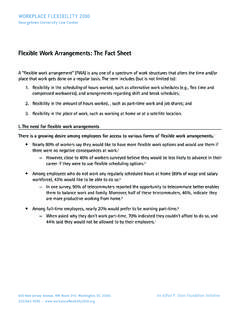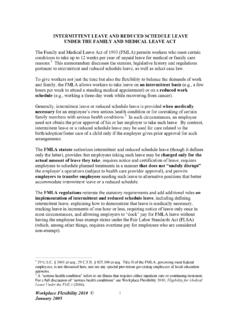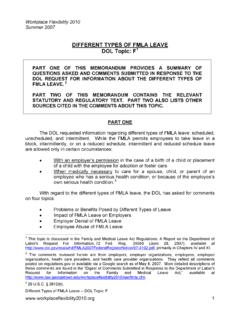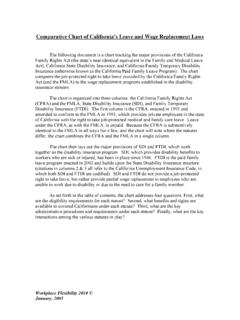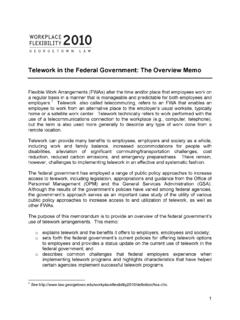Transcription of FAQs about Employees and Employee Benefits
1 faqs about Employees and Employee BenefitsPamela Perun-2-TABLE OF .. Benefits Basics .. 5Q-1. What are Employee Benefits ? .. 5Q-2. What laws apply to Employee Benefits ? .. 5Q-3. Under ERISA, what is an Employee benefit plan? .. 6Q-4. What is a plan? .. 6Q-5. Who is an employer or an Employee organization? .. 7Q-6. Who is an Employee ? .. 7Q-7. Who is a participant? .. 7Q-8. What are the primary types of plans? .. 7Q-9. What is a welfare plan? .. 8Q-10. What is a pension plan? ..8Q-11. What plans are exempt from ERISA?.. Plan Basics .. 9Q-12. What laws govern pension plans?
2 9Q-13. What is a qualified pension plan?..9Q-14. Are all employer-sponsored pension plans qualified plans?..9Q-15. Are there many types of pension plans?.. 10Q-16. Can non- Employees participate in a qualified plan?.. 10Q-17. Who is eligible to participate in a pension plan?.. 10Q-18. What are the rules about part-time workers in qualified plans?.. 10Q-19. What participation rules apply to qualified plans?.. 11Q-20. What are the coverage rules for qualified plans?.. 11Q-21. What are the tests for discriminatory Benefits in qualified plans?.. 12Q-22. What is the significance of the non-discrimination rules for plan participation?
3 12Q-23. Do other types of pension plans have non-discrimination rules?.. 13Q-24. Is there a pension alternative for Employees without an employer-sponsored plan? .. Plan Basics .. 13Q-25. Does ERISA set eligibility standards for welfare plans?.. 13Q-26. What role does the IRC play in welfare plans?.. 13Q-27. What are health plans?.. 13Q-28. What are the non-discrimination rules of self-funded health plans?.. 14Q-29. What are the non-discrimination rules for group-term life insurance? .. 14Q-30. Are there similar non-discrimination rules for other welfare Benefits ? .. 15-3-Q-31.
4 What is a cafeteria plan? .. 16Q-32. What are flexible spending arrangements and health reimbursement arrangements? .. 17Q-33. What are health savings accounts?.. 17Q-34. Is there a health care alternative for Employees without an employer-sponsored plan?.. Basics .. 18Q-35. What role does the Age Discrimination in Employment Act (ADEA) play inemployee Benefits plans? .. 18Q-36. How does the ADEA apply to Employee Benefits ?.. 18Q-37. What effect has the ADEA had on Employee Benefits plans?.. A .. B .. primer is an introduction to the basic laws of Employee Benefits .
5 It is often assumedthat there are legal impediments to employers providing Benefits to phased retirees, part-timeworkers and the contingent workforce. From a Benefits law perspective, this is really not true. Bystatute, self-employed workers are sometimes excluded from plans required to be Employee -onlybut employers face few other prohibitions when designing their plans. From an employer s perspective, there are far more impediments to excluding these workersfrom their benefit plans than including them. Tax law provides incentives to employers who sponsorplans and to workers who participate in them.
6 But tax law also insists that this special treatmentshould not be available only to high-paid workers. So today s regulatory structure is intended tocompel employers to include a substantial number of rank-and-file and lower-paid workers in theirplans in exchange for favorable tax treatment for high-paid primer illustrates this regulatory structure by focusing on the basic rules for eligibilityand participation in the most common plans. It is in part an exercise in mapping the employeebenefits universe. It is written from the perspective of an employer and highlights questions that anemployer must answer when designing a particular plan.
7 Those questions range from who is anemployee to how many low-paid workers must I include to what Benefits may I offer and towhom? By providing a road map, this primer is also intended to illustrate the basic rules ofemployee benefit laws. These rules include some elementary rules about eligibility and participationthat could be changed to mandate greater inclusion of phased retirees, part-time workers and thecontingent workforce. But it is unlikely that such a broad-brush reform could be achieved. Morelikely avenues for change are the non-discrimination rules that apply to most Employee rules require employers to give more lower-paid Employees more Benefits than they otherwisemight and more than the basic rules require.
8 Harmonizing standards, tightening rules and tweakingdefinitions under these rules may be a more pragmatic approach to expanding benefit options tomore non-discrimination rules are admittedly difficult, complicated and often it is not necessary or even desirable to attempt to master them. They are included for the purposeof illustrating the variety of tests, definitions and standards now in effect as part of this exercise inmapping the landscape of Employee Benefits plans. Benefits BasicsQ-1. What are Employee Benefits ?A-1. Employers typically provide their workers with a variety of Benefits in addition towages and salaries.
9 These are commonly called fringe Benefits . Fringe Benefits include all typesand sizes of Benefits such as Employee discounts, club memberships, employer-provided meals,educational assistance as well as pension and health plans. Under the general tax rule, workers aretaxable on the fair market value of fringe Benefits and employers may deduct their benefit costsevery year, unless a specific tax statute provides otherwise. [IRC 61(a) defines taxable income toworkers and includes compensation for services, including .. fringe Benefits , IRC 162(a) permitsemployers a deduction for reasonable salaries or other compensation for personal services, andIRC 132 excludes certain types of fringe Benefits from taxation.]
10 ] Employee Benefits are a special subset of fringe Benefits . There is no single definition forthis term but it typically refers to employer-sponsored plans that are subject to the EmployeeRetirement Income Security Act of 1974 ( ERISA ) and have special tax rules. ERISA containstechnical definitions for the term Employee benefit plans [ERISA 3(3)].Q-2. What laws apply to Employee Benefits ? A-2. There are three major laws: the Internal Revenue Code ( IRC ) [26 USC 1 et seq.],ERISA [29 USC 1001 et seq.], and the Age Discrimination in Employment Act ( ADEA ) [29 USC 621 et seq.
